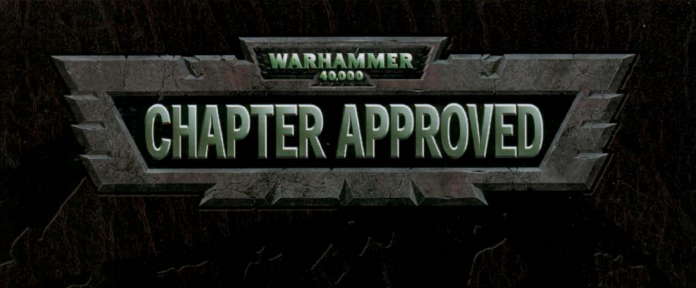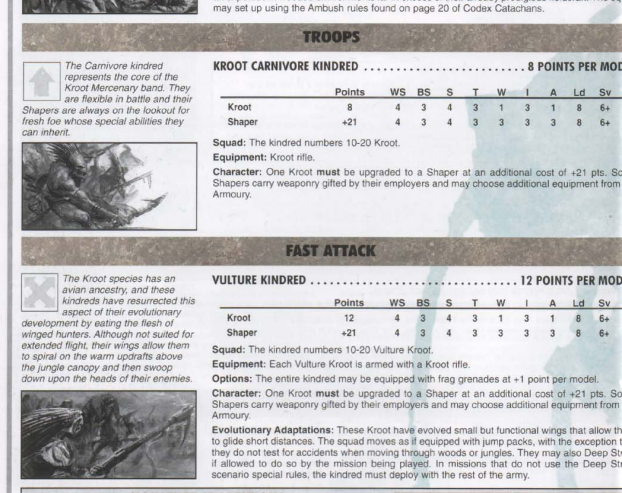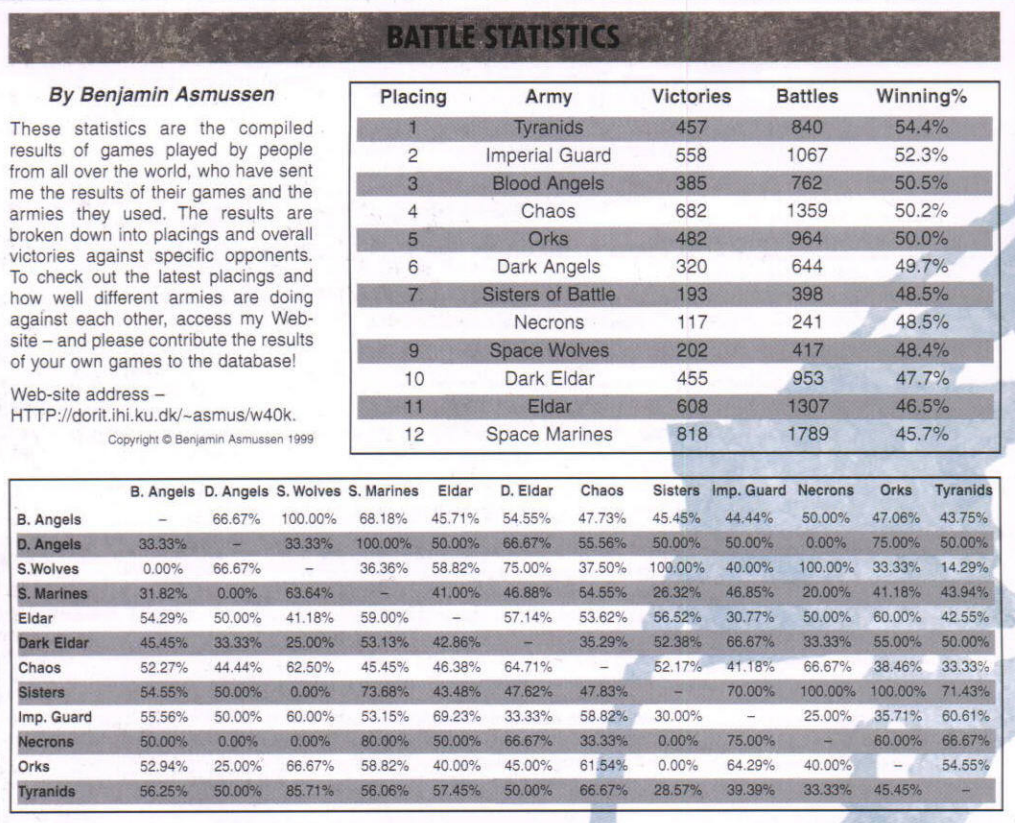Welcome back to the final article of GOONHAMMER ’02, where we look back at the games that defined the year and our favorite games during the year. Today we’re looking at Chapter Approved 2003, one of the final releases of the year and one of the most interesting time capsules of 40k rules.
Boon: On November 30th, 2002 Games Workshop published the third installment of Chapter Approved, subtitled the Third Book of the Astronomican. It was a reference to the original released in 1988 in support of Rogue Trader and was preceded by the Second Book in July of 2001 and then superceded the following year in 2004, which would be the last Chapter Approved released until its reintroduction in 2018. Led by the Warhammer 40k ‘Overfiend’ Andy Chambers, Chapter Approved was an outlet for the Warhammer 40,000 team including Andy Hoare, Phil Kelly, Pete Haines, and Gav Thorpe as well as other contributors to introduce new ideas, answer community rules questions, provide corrections and errata, and importantly make necessary rule changes to support the wider 40k gaming community. The book was 137 pages filled with content that covered new Army Lists, Rules, Scenarios, Questions & Answers, Released Codex Updates, and of course, a Hobby corner which served to broadly celebrate the community. Today we’ll reflect on this fantastic publication and its parallels to today.
As a brief aside, it is hard to understate just how important White Dwarf, the foundation for Chapter Approved, was as a publication in its time. For those who are younger or newer to the hobby, the internet and social media has become the end-all-be-all of community resources. In the early 2000s however, the internet was still relatively new and limited with limited access. Message boards like Portent (now Warseer) and DakkaDakka as well as individually hosted websites were key community outlets for fans to engage and exchange ideas. But in terms of official guidance, White Dwarf was the vibrant driver of the hobby and a resource by which Games Workshop creators and designers spoke directly, in their own words, to the community on how they thought about the game, the rules, and the introduction of new ideas. While the decline of print media over the ensuing decades has come for every corner of the medium, the ideas and methods that White Dwarf encapsulated are every bit as relevant today and a topic we may seek to touch on in future articles.
Army Lists
Boon: The first third of the book was dedicated to collating the introduction of new army lists and variants that expanded the opportunities within the game. As is the case now, much of what was included leveraged parallel elements of the game: Forge World, the war for Armageddon, City Fight, or Dan Abnett’s Gaunt’s Ghosts novel series, to tie in the world-building of the Warhammer universe with the playable table-top game. In 2002, these additions came in the form of:
- Feral Orks
- Gaunt’s Ghosts
- Armageddon Imperial Guard Regiments
- Kroot Mercenaries
- Tyranid Seeding Swarms
TheChirurgeon: In execution these are a mix between Supplements (guard regiments) and Armies of Renown (Tyranid Seeding Swarms), although many of the particular benefits those offer, such as Stratagems and Warlord Traits, weren’t yet a part of the game.

Feral Orks
Feral Orks were those Orks maturing in the aftermath of an invasion and left without the kulutral know-how to find their own way after the Waaagh had already moved on. Fending for themselves and identifying themselves by the biggest threats they faced to their slowly accumulating tribe. As a sub-faction they were particularly brutish but no less deadly than the traditional Ork flavor. The precursor to today’s Beastsnagga Boyz, the feral Orks were introduced into 40k alongside the now-iconic but rarely seen Squiggoth. First seen in Epic, the Squiggoth were the heavy support options for an army that lacked the ‘technology’ of its more traditional Ork brethren. The Squiggoths acted as transports and heavy weapon platforms for a mob of boyz and came in various sizes ranging from standard (up to 6”) to massive (over 9” – no limits here), which were reflected in their profile stat lines.
Boon: The squiggoth is such a cool unit in concept but criminally under supported and underutilized in the game. I think I can actually count on two fingers the number of times I’ve seen a completed and fully painted Squiggoth. I imagine most Ork players look upon the beast as I look upon my Wraithknights, with reverence and hope that some day it’ll be worthy to hit a tournament table. While the Killrig is cool, it’s just not a giant dinosaur of questionable lineage, bred by Pigdoks of questionable competency. Something about them just touches that wonder button in all of us.
TheChirurgeon: I’ll admit I don’t care much about feral orks, but they’re much more interested in the wake of the Beastsnaggas release, where they have more historical relevance as the precursor to a modern day faction. Mostly, this is here to give you a rules reason to buy the Forge World Squiggoth, which was a dope model.
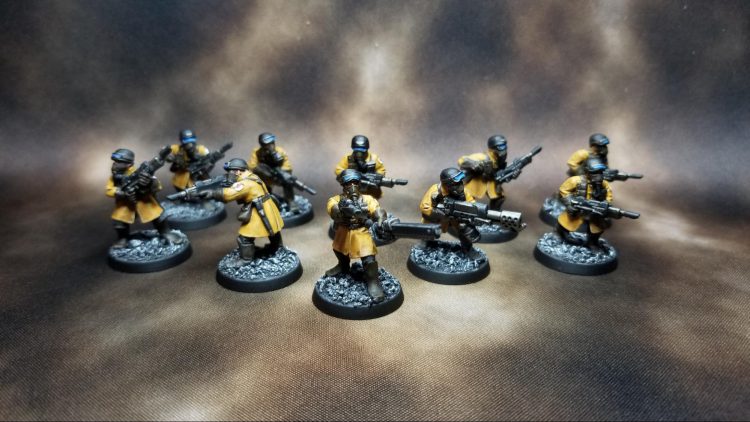
Imperial Regiments
In 2002 multiple now-iconic Imperial Guard regiments were introduced – first and foremost (or first and only) of these were the Tanith 1st of Dan Abnett’s now famous series. Alongside these fan favorites and in the wake of Armageddon, the Armageddon Ork Hunters, Death Korps of Krieg, Savlar Chem-Dogs, and the Elysian Drop Troops were also introduced.
All of these would soon be formally recognized in Imperial Armor and the second 3rd edition Imperial Guard Codex the following year. While Gaunt’s Ghosts was simply a command squad of unique individuals with their own rules and abilities, each new Imperial Guard regiment offered a set list of unit options and a bevy of special rules that gave them their own unique flavor. Interspersed with the lore and rules for how to use these unique regiments were additional tips on how to convert and model your very own regiments which, except for Gaunt’s Ghosts and the Death Korps of Krieg, did not have models for themselves at the time.
As was the hotness of the time, the section closed with special rules on how to use Imperial Guard regiments in the war-torn city landscapes of the 41st millennium.
TheChirurgeon: This is an interesting stop-gap for the Guard, who wouldn’t see their own second 3rd edition codex (or 3.5 edition) until October 2003. While that particular book is very highly regarded, the initial 1999 codex they were saddled with was terrible. These are more a fun thematic tie-in army than something to really boost the army’s power and get you by, but they’re still fun rules.
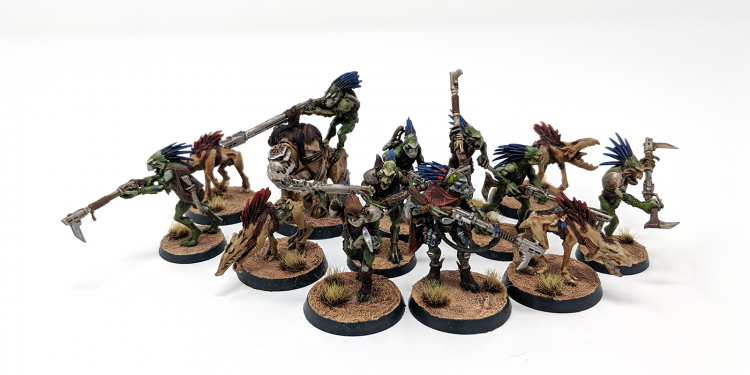
Kroot Mercenaries
The one time Tau were really cool. The introduction of the Kroot Mercenaries expanded a previously limited pool of Kroot units – a species of avian-like sentient carnivores that had filled in the Tau ranks with an expendable meat-grinder unit. First introduced in the November 2001 White Dwarf, Kroot mercenaries allowed a player to build a fully legal mercenary force completely independent of the main battleline Tau warriors. Led by a Kroot Shaper and featuring various flavors the basic Kroot warriors, large and brutish Krootox, and fast Kroot Hounds, the army was largely unsupported from a range perspective and would disappear altogether in the editions that followed – but for a brief, shining moment Kroot had their day in the sun.
TheChirurgeon: I find stumping for Kroot to be kind of silly, to be honest. I’ve always liked battlesuits. The all-kroot army is fine to have but it’s most just an odd novelty.
Boon: Novelty? Surely. Silly? Debatable. I’m almost ashamed to say that I picked up Tau at release because I too thought suits were cool (and to be honest, they definitely are). But even being a shithead teenager I thought that Tau were just kind of boring and the Kroot were easily the best part of the army. Today the Tau army is frankly far more dynamic, even in one phase, than they were then – stacking Kroot in front of Fire Warriors who sat in front of move-jump-move Crisis and then heavy Broadsides in some sort of mecha-anime colonial front-rank, second-rank mock-up just to gain cover saves was all I remember of that army. In that world, at least Kroot liked to punch stuff and benefitted from forest terrain every now and then.
Tyranid Seeding Swarms
Tyranid Seeding Swarms represent the Tyranid forces from the early days of an invasion, when the first waves arrive falling from the sky in Mycetic Spores. Seeding Swarms all benefit from the ability to Deep Strike to represent being in the first wave, and units can be upgraded to Ferocious (+1S and +1I) or Without Number for a game. Generally these armies tend to be very nasty, at the cost of firepower.
TheChirurgeon: Basically a Tyranids Army of Renown by today’s standards.
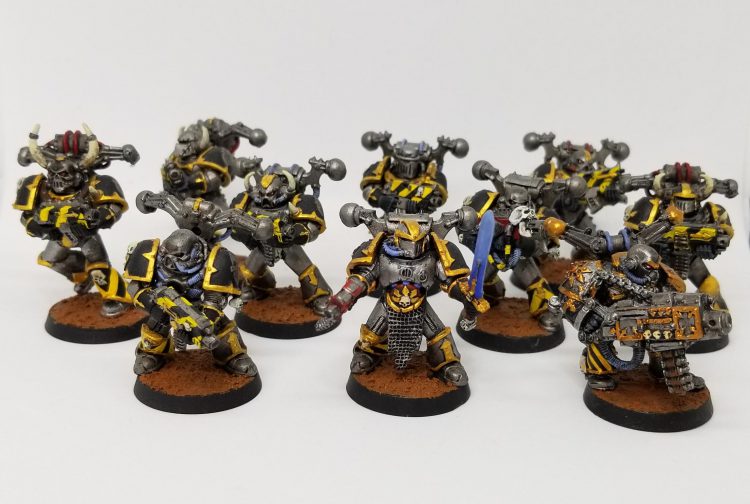
New Rules, Questions and Answers, & Codex Updates
The next third of the book is given over to updating core mechanics of the gameplay as well as addressing various rules-related questions and then finally closing with codex corrections (based on prior rules clarifications or changes). These sections combined trial rules, what we might call beta rules today, with designer feedback and input on the correct interpretation of a rule or the way it is to be played on the table. While the earlier section introduced new ideas and flavor to the game, keeping it fresh, this section was all about maintaining the games core integrity and intended manner of play.
In 2002, this section introduced trial rules that covered five separate topics; the assault phase, psykers, dedicated transports, and then new rules for including Deathwatch or an Emperor’s Champion in your Space Marine force.
Assault Phase Rework
After four years of third edition, the team took the opportunity to fully rework what was and still is the most complex element of the game – the assault phase. Specifically derived to streamline the experience for veteran and tournament players, the trial rules sought to remove some of the gamey-ness of the original third edition ruleset and facilitate a more refined experience. Throughout the section designer’s notes were added to help explain the logic of the changes – a very common practice at the time.
TheChirurgeon: These rules were a big deal, and the Assault phase rules would basically become the melee rules for 4th edition. In a lot of ways, 4th was 3rd with these beta rules added in, plus a few other tweaks and some terrible codexes.
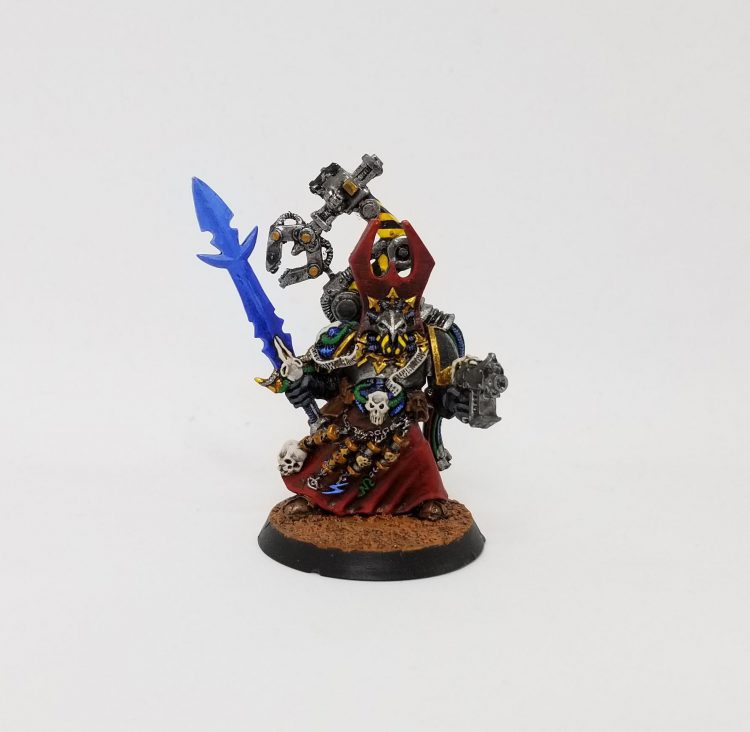
Psykers
Perhaps one of the more interesting trial rules in the book, this section both acknowledged the relative lack of importance of psykers in the overall game and accordingly sought to boost their effectiveness. The way this was done was by adding Minor Psychic powers, additional powers you could roll for if you paid some additional points, in a similar fashion to what Thousand Sons Chaos Space Marines got in their 3.5 book. There were four minor power tables to roll on, and these each had 5 powers (rolling a 1 meant you got nothing). These were… OK. They were beta/optional rules at the time, so they were more for getting player feedback. Still, you can see where they’d come back to this in sixth edition with the more generic psychic power tables.
TheChirurgeon: After 2nd edition’s Dark Millennium supplement bogged down the game with long psychic phases involving warp cards, 3rd edition refreshingly made most psychic powers into attacks and effects used in the Shooting phase. This was, unfortunately, also kind of boring. They wouldn’t really redo this whole cloth until 6th edition, when they brought back the psychic phase. Even today, GW struggles with the question of psyker relevance.
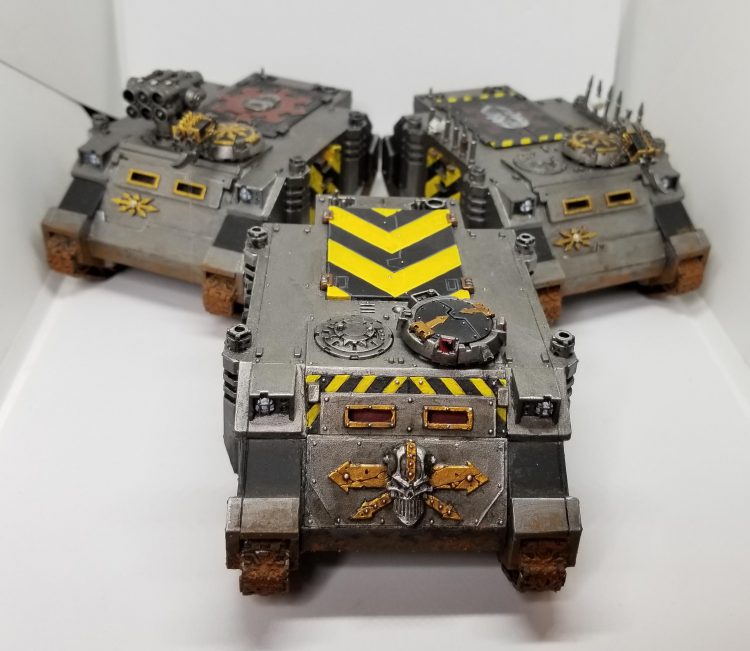
Dedicated Transports
Unhappy with the transport rules released at the start of 3rd edition, the designers took another pass at transport rules, adding some complexity and making many of the game’s transports more useful. In particular, every vehicle got Fire Points, which represented slits and openings that passengers could shoot out of (open-topped vehicles had unlimited fire points), and Access Points, which now dictated where and how units could embark and disembark. Instead of just having to be near the vehicle, you had to be near an entry ramp or door.
In addition to this, special rules were added for several important vehicles, such as the Land Raider gaining the Machine Spirit rules for the first time, to allow it to shoot additional weapons on the move or move while shaken or stunned. Likewise the Rhino gained an emergency repair rule.
TheChirurgeon: These rules were a huge boon for marine armies, and helped power the Rhino Rush strategy forward, since now you could take a couple of meltaguns who could pop off out of the top hatch of the vehicle as it ambled forward to deliver its deadly cargo. It also made Land Raiders significantly more useful.
Deathwatch & Emperor’s Champion
TheChirurgeon: Reprinted from White Dwarf here were the official rules for the Deathwatch. The Deathwatch rules only consisted of a single squad, but they could be included in any Imperium army (at the time defined as space marines, imperial guard, or sisters) as an HQ choice. Deathwatch Kill Teams were composed of a mix of regular marines and veterans (i.e. marines with 2 attacks), and had access to a ton of wargear, including special issue ammo, though you had to buy the ammo you wanted prior to the game. Otherwise, Deathwatch marine were just better space marines, with true grit (use bolters as a pistol in melee) and the ability to teleport onto the battlefield.
Also reprinted here were rules for the Emperor’s Champion, sporting its brand new model. While the Emperor’s Champion was optional in Space Marine Armies except for Black Templars, where you had to take one, even if the players agreed not to use special characters beforehand. This portended one of the worse aspects of 4th edition’s rules: Having to take a chapter’s special character to gain access to the chapter rules. As a fighter, the Emperor’s Champion was solid, sporting WS and I 5, 2 wounds, 2 attacks and the black sword, which could either be used as a +1S power sword or a power fist, depending on whether you wanted to go Kendo style with it. Strong Kenpachi energy there.
The other rule for the Emperor’s Champion was that he could issue challenges, forcing some coward to come out into the street and fight him. This would later just become a rule anyone could use in the godforsaken time known as 6th and 7th edition.
Scenarios & Hobby
Boon: The final third of the book was dedicated to the hobby and the community and showcased tips and tricks from veteran gamers and painters on how to play the game, and importantly, inspirational paintjobs and tutorials. As with White Dwarf at the time, closing of the book included a listing of all the registered clubs and hobby shops the world over that were registered in the The Gaming Club Network as well as some fan letters and tournament champions.
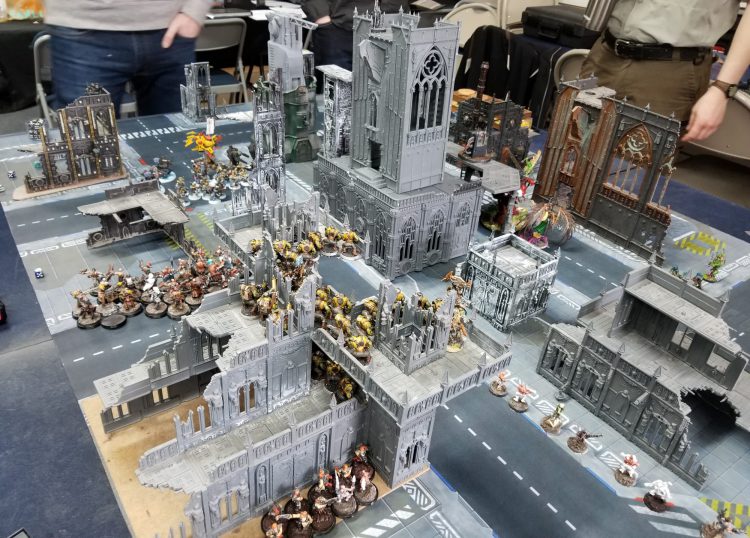
Cityfight Tactica
TheChirurgeon: Games Workshop released one campaign book during third edition: Cityfight, which introduced rules for fighting battles in choked city streets strewn with rubble. In addition to mixing up the base rules a bit (offering more cover, navigating difficult terrain, using sewers, etc.), the rules also introduced a campaign framework, with additional tactical options for armies. It was a cool ruleset, and would be iterated on many times through several editions, most recently with Urban Combat in 8th edition.
Chapter Approved 2003 adds on to the Cityfight rules by adding Sub-plots, a series of randomly determined additional effects for Cityfight battles. Before a battle, each player rolls a D3 for the table they’ll roll on, then a D6 for the effect. The three options are Random events, which affect the whole battlefield, Secret Ploys, which benefit a specific player, and Legacies of War, which also benefit a player. These could be pretty uneven but they added some additional ways to gain XP for your units and shake things up in the game.
Grand Tournament Winners
Boon: Newer members of the community understand that Games Workshop leads a tournament series within the US, and potentially beyond. It’s new, it’s exciting, it’s a lot of fun. However, it’s actually an old idea – the Games Workshop Grand Tournaments had multiple years of global championship events and often supported the more local, independent events through the Rogue Trader Tournament scheme that were often registered directly with GW. I may still have a couple of tournament trophies and tournament champion shirts laying around (I may or may not have recently raided my parents basement to dig up old, way oversized shirts). As is the case today, the community events team celebrated these events and champions in the public space – before the dark times, before it all closed up shop and a massive void was left in its place. Before the rise of the Independent Tournament Circuit (now subtly changed to the International Tournament Circuit with Games Workshop stepping back into the fold). This section is a nod to a fun bit of history and an acknowledgement that the conversation was always an inclusive one.
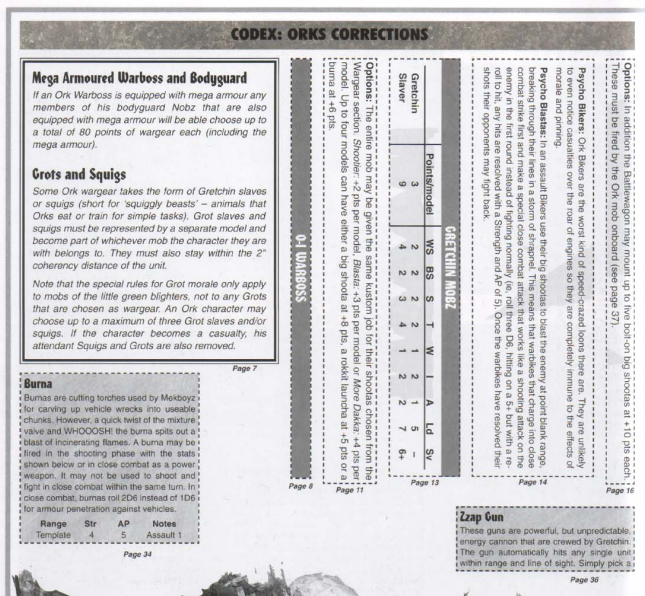
Corrections
TheChirurgeon: Last but not least, there’s an entire section dedicated to fixing errors or correcting parts of different books, with cut-out sections you’re meant to paste or tape directly into your existing book! This was a huge departure from the “never update anything” strategy that would come before and after.
Final Thoughts
Boon: I think it has been commonly lost in our collective memory of Warhammer 40,000 that its history is one of varying levels of attention to the playability and balance of the game – what I’d call the ‘health’ of the game. The year 2002 saw the third compilation of White Dwarf rules and adjustments geared for the casual player as well as the introduction of whole new rules designed primarily for the tournament player. The history of these Chapter Approved show time and again the attempt to bridge that gap between 40k as a casual beer & pretzel game amongst friends and a competitive game amongst tournament players (and friends) – and it’s done in a manner that is not mutually exclusive.
This was a time in which the game designers spoke plainly and directly to the community. A different time to be sure, and one in which we’re unlikely to ever see such plain honesty again. It’s the hallmark of a small, private company yet to be saddled with the responsibility to the public for an IP so valuable that the kind of engagement we saw then could well be a liability now. But the lessons of what it meant to the community; to know who designed their rules, to know that they cared, that they were personally invested and spoke to them directly – it was important. It still is. Some of that may be lost today, but I’d argue that it doesn’t need to be. We’re not going to see whole columns of Andy Chambers lamenting the negative fan mail he’s received over a correction to a codex, but might we see more designer’s notes in the future? I’d argue that any time you can place that personal stamp, to make that connection with the hobbyist, casual or competitive, that it’s both valued and valuable. We’ve seen designer’s notes from time to time but looking back now it’s clear how stark the difference is. I may be nostalgic, I may be pining for days gone by, but I honestly miss it. It felt more welcoming, less sterile – it felt like we were in it together on our crazy, stupid hobby that we love.
I think to close, I’d like to bring in something interesting from the second edition of Chapter Approved. Tucked away in the community section, beyond the community letters but just prior to some piece of fan faction that Jervis Johnson found funny, was a collection of community statistics collected by Benjamin Asmussen. Clearly the stats-daddy of Peter ‘The Falcon’ Colisimo, Benjamin had compiled win rates on each faction at the time and their relative splits into each other (see below).
I think what I find the most fascinating here is that this snapshot in time showcases a game that I think any of us would be envious of today. Contrary to the common retort of “It’s always been this way” when any discussion of imbalance in the game arises, we see here that it’s not really true. If asked what people would like to see in the game, a faction win rate spread between 45% and 55% is a fairly acceptable answer to most and a far cry from what we see today. As then, we rely on the support of the heavily invested community to bring us these insights, but what is significant here is that even then Games Workshop cared enough to showcase that balance as both an informational tool and an acknowledgement of its merit within its flagship annual.
There are no true parallels from history, merely echoes of a likeness – but we would do well to learn what we can from those and apply the relevant lessons to our future. Both as a design team and as a community with a sense of common purpose.
TheChirurgeon: The old Chapter Approved books are probably the most interesting artefacts of older editions, as they give us direct insight into how the designers thought about the game and wanted to approach the rules as a living document. This is especially true when you look at the pages dedicated to a large number of errata and rule updates that are meant to be cut out of the book and pasted/taped into your existing codex! There’s a willingness here to tinker with the game and play around with its structure that you just don’t see in modern times, where it seems like Games Workshop is caught between the idea that the game needs regular updates and the idea that the $50 hardcover rulebooks it sells are sacrosanct.
But it’s worth noting that the game was massively different back then. When Boon laments the loss of a series of 45-55% win rates – which I’ll agree is ideal – he’s also looking at a game that had, at the time, 12 factions, many of which had half the units they have today (and that win rate table likely does not include the impact of the new Chaos Marines book). And that’s not to mention the simplicity of the game itself, which had few psykers and psychic powers, no stratagems, and fewer ways to customize units. Note however, that I do not necessarily think this made the game better, only simpler.
Likewise, it may be easier to sell your players on book updates when your codex is a softcover book retailing for $20-25, though it’s worth noting that those books would still be closer to $40-45 in today’s money. At the time, we liked these updates and changes – the benefits of shoring up a bad book or unit far outweighed the downsides of having to track a change to your army, but then again these updates happened in two places: White Dwarf, and Chapter Approved, and GW was consistent over those three years about reprinting White Dwarf articles in CA supplements.
And then 4th edition happened and with it came a major shift in the game’s design and release philosophy, most of it bad. The rules were tightened up but army choices were pared down and removed and Chapter Approved updates stopped, not releasing again until 8th edition in 2017. As you may find out if we do “GOONHAMMER ‘08” next year, I wasn’t a fan of the 4th/5th editions of 40k and how they changed the game. We’re certainly living in a better, more enlightened time now (in some ways, at least), but it’s interesting to see how these challenges were solved in the early days of the internet when channels were limited.
Have any questions or feedback? Drop us a note in the comments below or email us at contact@goonhammer.com.
